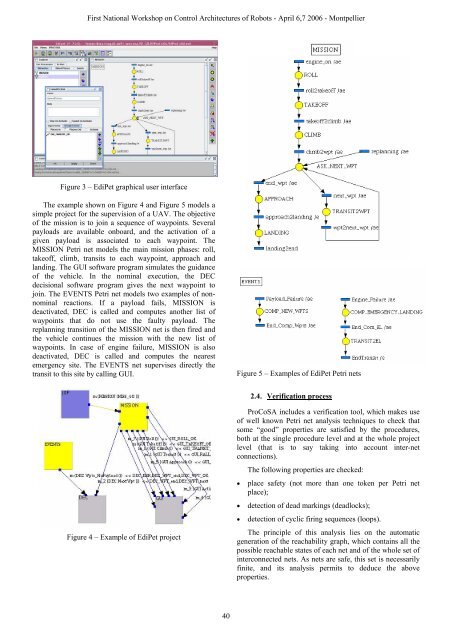Pleading for open modular architectures - Lirmm
Pleading for open modular architectures - Lirmm
Pleading for open modular architectures - Lirmm
You also want an ePaper? Increase the reach of your titles
YUMPU automatically turns print PDFs into web optimized ePapers that Google loves.
First National Workshop on Control Architectures of Robots - April 6,7 2006 - Montpellier<br />
Figure 3 – EdiPet graphical user interface<br />
The example shown on Figure 4 and Figure 5 models a<br />
simple project <strong>for</strong> the supervision of a UAV. The objective<br />
of the mission is to join a sequence of waypoints. Several<br />
payloads are available onboard, and the activation of a<br />
given payload is associated to each waypoint. The<br />
MISSION Petri net models the main mission phases: roll,<br />
takeoff, climb, transits to each waypoint, approach and<br />
landing. The GUI software program simulates the guidance<br />
of the vehicle. In the nominal execution, the DEC<br />
decisional software program gives the next waypoint to<br />
join. The EVENTS Petri net models two examples of nonnominal<br />
reactions. If a payload fails, MISSION is<br />
deactivated, DEC is called and computes another list of<br />
waypoints that do not use the faulty payload. The<br />
replanning transition of the MISSION net is then fired and<br />
the vehicle continues the mission with the new list of<br />
waypoints. In case of engine failure, MISSION is also<br />
deactivated, DEC is called and computes the nearest<br />
emergency site. The EVENTS net supervises directly the<br />
transit to this site by calling GUI.<br />
Figure 4 – Example of EdiPet project<br />
40<br />
Figure 5 – Examples of EdiPet Petri nets<br />
2.4. Verification process<br />
ProCoSA includes a verification tool, which makes use<br />
of well known Petri net analysis techniques to check that<br />
some “good” properties are satisfied by the procedures,<br />
both at the single procedure level and at the whole project<br />
level (that is to say taking into account inter-net<br />
connections).<br />
The following properties are checked:<br />
• place safety (not more than one token per Petri net<br />
place);<br />
• detection of dead markings (deadlocks);<br />
• detection of cyclic firing sequences (loops).<br />
The principle of this analysis lies on the automatic<br />
generation of the reachability graph, which contains all the<br />
possible reachable states of each net and of the whole set of<br />
interconnected nets. As nets are safe, this set is necessarily<br />
finite, and its analysis permits to deduce the above<br />
properties.

















